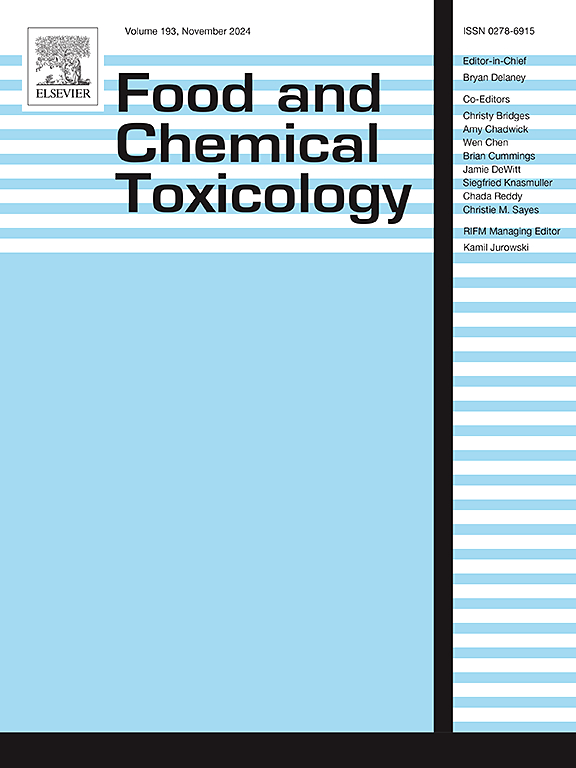Molecular insights of T-2 toxin exposure-induced neurotoxicity and the neuroprotective effect of dimethyl fumarate
IF 3.9
3区 医学
Q2 FOOD SCIENCE & TECHNOLOGY
引用次数: 0
Abstract
T-2 toxin, a potent environmental pollutant, has been proved to stimulate neuroinflammation, while the connection between T-2 toxin and pyroptosis remain elusive. Dimethyl fumarate (DMF), recently identified as a neuroprotectant and pyroptosis inhibitor, has potential therapeutic applications that are underexplored. Based on present study in vitro and vivo, we demonstrated that T-2 toxin induced the activation of NLRP3-Caspase-1 inflammasome in hippocampal neurons. In addition to proinflammatory mediator overexpression, gasdermin D (GSDMD)-dependently pyroptosis in the mouse hippocampal neuron cell line (HT22) treated by T-2 toxin was determined in our study. Moreover, the palliative effect of knockdown sequence of high mobility group B1 protein (HMGB1) provided more details for T-2 toxin-initiated pyroptosis. Importantly, we confirmed that DMF, as a novel inhibitor of GSDMD, could alleviate pyroptosis induced by T-2 toxin in an GSDMD targeting manner. In summary, our studies exposed the evidence that T-2 toxin could induce NLRP3 inflammasome activation and hippocampal neuronal pyroptosis. More notably, DMF was turn out to be a critical executioner for attenuating GSDMD-mediated pyroptosis. Our data found a new function of DMF and suggested a novel therapy strategy against mycotoxin-triggered neuronal inflammation, which leads to varieties of neurological diseases.

T-2毒素暴露诱导的神经毒性和富马酸二甲酯的神经保护作用的分子机制。
T-2毒素是一种强效的环境污染物,已被证明可刺激神经炎症,但T-2毒素与焦亡之间的联系尚不明确。富马酸二甲酯(DMF),最近被确定为神经保护剂和焦亡抑制剂,具有潜在的治疗应用尚未开发。在体外和体内实验的基础上,我们证实了T-2毒素诱导海马神经元NLRP3-Caspase-1炎症小体的激活。除促炎介质过表达外,本研究还检测了T-2毒素处理小鼠海马神经元细胞系(HT22)中gasdermin D (GSDMD)依赖性焦亡。此外,高迁移率组B1蛋白(HMGB1)敲低序列的缓解作用为T-2毒素引发的焦亡提供了更多的细节。重要的是,我们证实了DMF作为一种新的GSDMD抑制剂,能够以GSDMD靶向的方式减轻T-2毒素诱导的焦亡。总之,我们的研究揭示了T-2毒素可诱导NLRP3炎性体活化和海马神经元焦亡的证据。更值得注意的是,DMF被证明是减弱gsdmd介导的焦亡的关键刽子手。我们的数据发现了DMF的新功能,并提出了一种新的治疗策略,用于治疗真菌毒素引发的神经元炎症,这导致了各种神经系统疾病。
本文章由计算机程序翻译,如有差异,请以英文原文为准。
求助全文
约1分钟内获得全文
求助全文
来源期刊

Food and Chemical Toxicology
工程技术-毒理学
CiteScore
10.90
自引率
4.70%
发文量
651
审稿时长
31 days
期刊介绍:
Food and Chemical Toxicology (FCT), an internationally renowned journal, that publishes original research articles and reviews on toxic effects, in animals and humans, of natural or synthetic chemicals occurring in the human environment with particular emphasis on food, drugs, and chemicals, including agricultural and industrial safety, and consumer product safety. Areas such as safety evaluation of novel foods and ingredients, biotechnologically-derived products, and nanomaterials are included in the scope of the journal. FCT also encourages submission of papers on inter-relationships between nutrition and toxicology and on in vitro techniques, particularly those fostering the 3 Rs.
The principal aim of the journal is to publish high impact, scholarly work and to serve as a multidisciplinary forum for research in toxicology. Papers submitted will be judged on the basis of scientific originality and contribution to the field, quality and subject matter. Studies should address at least one of the following:
-Adverse physiological/biochemical, or pathological changes induced by specific defined substances
-New techniques for assessing potential toxicity, including molecular biology
-Mechanisms underlying toxic phenomena
-Toxicological examinations of specific chemicals or consumer products, both those showing adverse effects and those demonstrating safety, that meet current standards of scientific acceptability.
Authors must clearly and briefly identify what novel toxic effect (s) or toxic mechanism (s) of the chemical are being reported and what their significance is in the abstract. Furthermore, sufficient doses should be included in order to provide information on NOAEL/LOAEL values.
文献相关原料
公司名称
产品信息
索莱宝
VX-765
索莱宝
VX-765
索莱宝
VX-765
 求助内容:
求助内容: 应助结果提醒方式:
应助结果提醒方式:


